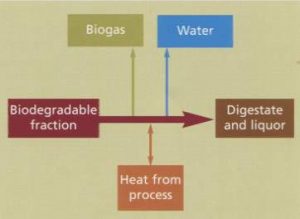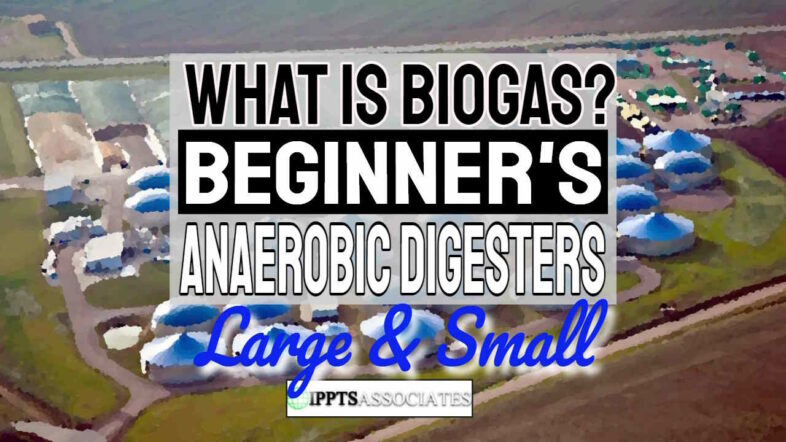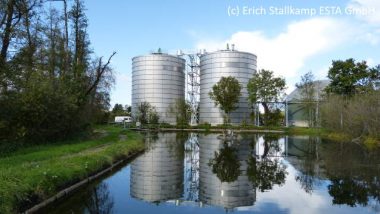We answer the question: “What is Biogas?”
Biogas is generated during anaerobic digestion (AD) when microorganisms break down (by eating it) organic materials in the absence of air (or oxygen). Biogas is mostly methane (CH4) and carbon dioxide (CO2), with very small amounts of water vapor and other gases. The carbon dioxide and other gases can be removed, leaving only the methane.
On This Page
- What is Biogas?
- Why is Biogas Important?
- What is the Cost of the Source of Biogas Energy?
- What is Biogas Used for?
- What is Biogas Made of?
- What is a Biogas Generator?
- What is Biogas Production
- The Working of Biogas Plants
- The Types of Biogas
- The Biogas Digester
- The Importance of Biogas
- Biogas Advantages
- Disadvantages of Biogas
- Biogas Yield
- The Methane Content
- Biogas Boiler Design
- Biogas Heating System
- Biogas Cost
- What is its Future?
Methane is the primary component of natural gas. The material that flows out after anaerobic digestion happens is called “digestate.” Digestate is a wet mixture that is usually separated into a solid and a liquid. Digestate is rich in nutrients and can be used as fertilizer for crops.
In the process of anaerobic digestion, as mentioned above, the bacterial breakdown of organic materials in the absence of oxygen produces biogas.
The process occurs in the following four steps:
- Hydrolysis: large polymers are broken down by enzymes
- Acidogenesis: acidogenetic fermentations are most important, acetate is the main end product. Volatile fatty acids are also produced at this stage along with carbon dioxide and hydrogen.
- Acetogenesis: breakdown of volatile acids to acetate and hydrogen.
- Methanogenesis: acetate and hydrogen are converted to methane and carbon dioxide.
And, the result is the sustainable renewable energy source (sometimes also spelt as) “bio-gas”.

Why is Biogas Important?
Biogas is important because it is a rare and badly needed commodity in these times of climate change. it's important as a source of green and clean energy. It's also important in other ways as well.
a) It Can be a Significant Contributor to Reducing Global Carbon Dioxide Emissions
In December 2019 the World Biogas Association presented the UNFCCC with an industry commitment. Major biogas industry players committed to delivering a 12% reduction in global greenhouse gas emissions by 2030 provided world governments help unlock the sector’s potential.
b) An Untapped Material Supply with the Scope to Enlarge

As we said at the start, it is made from the biological breakdown of organic matter. There is a huge quantity of waste organic material available that can be used. The waste organic material which can be used includes feed materials (feedstocks) such as :
- all kinds of animal dung/ manure,
- kitchen waste, and waste from commercial food processing
- dead plants etc. including the parts of food crops which are not food, such as the stems and leaves.
The important point about this is that it can be used as a gaseous fuel. Methane is a gas which provides good caloric values when used as fuel.
What is more, at the moment less than one-tenth of the available waste organic matter which could be easily digested to make biogas is being used.
c) It's Already a Cooking Fuel in India and Similar Nations
Biogas produced from the anaerobic disintegration of manure in small pits in India is called Gobar Gas. Many other developing nations, including China, also make their biogas this way
 Gobar gas is also very important because it is estimated that over two million households in India already make their own gobar gas for cooking. They do this easily using dung from their own cattle. It is a popular source of fuel in many parts.
Gobar gas is also very important because it is estimated that over two million households in India already make their own gobar gas for cooking. They do this easily using dung from their own cattle. It is a popular source of fuel in many parts.
d) It Recycles as Part of a Circular Economy
Anaerobic digestion delivers two types of recovery from organic waste in a virtuous carbon circle:
- Agronomic waste recovery: with the production of compost, and energy in the form of biogas, electricity or heat. This technology is widely used across Europe and is gaining momentum all around the world. It provides an answer to one of the current challenges facing the farming sector. The sector must now design new models of production taking into account environmental constraints, and big reductions in carbon emissions, while still improving competitiveness and feeding the ever-rising population.
- Industrial and Commercial waste recovery: again with the production of compost and energy but more wide-ranging types of organic waste, from the likes of the food and beverage industries. Plus, waste from municipalities, such as green waste from parks and gardens and the byproducts from wastewater treatment plants.
Unlike incineration, precious organic material is retained to provide fertilizers and soil improvers which is a very important function. If the output from a biogas plant is made into charcoal (char) it can be put back on the land to improve soil quality while also acting as carbon storage (also known as carbon sequestration).
What is the Cost of the Source of Biogas Energy
 Often there are no charges for this energy source. A large proportion of the raw materials, in particular manure and plant residues, are generally available free of charge. There is no transport needed when the digester is built on-farm.
Often there are no charges for this energy source. A large proportion of the raw materials, in particular manure and plant residues, are generally available free of charge. There is no transport needed when the digester is built on-farm.
Using “waste” raw materials has the greatest economic potential for the production of biogas.
These materials may even be more cheaply treated using AD plants, where taxes are charged for disposing of that material to landfill.
Compare that with the cost of mining fossil fuels for energy!
What is Biogas Used for?
It is a great gas to use for domestic cooking and that's what gobs gas is used for as described earlier.
In agriculture, it can be used on-farm for heating farm buildings and the farmhouse. Any excess can be used for generating electricity which can be sold for an income.
Biogas can be used for electricity production at sewage works, in a CHP gas engine, where the waste heat from the engine is conveniently used for heating the digester.
If purified (upgraded) it can be compressed to replace compressed natural gas for use in vehicles, where it can fuel an internal combustion engine. Or it can be used in fuel cells. in both the later uses it is a much more effective displacer of non-renewable carbon dioxide than the normal use in on-site CHP plants.
What is Biogas Made of

The composition of biogas varies depending on the substrate composition, as well as the conditions within the anaerobic reactor (temperature, pH, and substrate concentration).
Landfill gas is a form of this gas. It typically has methane concentrations of around 50%.
Digester gas produced using advanced waste treatment technologies can produce biogas with 55%–75% methane, which for reactors with free liquids can be increased to 80%–90% methane using in-situ gas purification techniques.
What is a Biogas Generator?
A biogas generator is any machine, mechanical plant and equipment that converts waste into clean energy!
Many people make their own Biogas Generator to produce their own “natural” gas. For example, you can do it in a way that transforms grass clippings, food waste and livestock manure into renewable biogas energy with a homemade biogas generator
What is Biogas Production?
It's the making of this biofuel.
Most biogas production takes place in processing facilities (plants) which rely on anaerobic digestion, a fermentation process in which waste is digested by microbes to produce a predominantly methane gas (biogas). Almost any organic waste can be used in the process, though factors such as ph and temperature affect gas production.
The Working of Biogas Plants
During the process, the micro-organisms transform biomass waste into biogas (mainly methane and carbon dioxide) and digestate. Higher quantities of biogas can be produced when the wastewater is co-digested with other residuals from the dairy industry, sugar industry, or brewery industry.
For example, while mixing 90% of wastewater from a beer factory with 10% cow whey, the production of biogas was increased by 2.5 times compared to the biogas produced by wastewater from the brewery only.
The Types of Biogas Plants

Common biogas plant types can be differentiated according to methods of substrate feed, biogas collecting methods, materials used for their construction, horizontal or vertical digester position, underground and above-ground digester location and according to additional equipment used.
There are many different types. Here are some examples:
Batch biogas plants
- Wet Process Batch Digester (for example a laboratory trial digester used to find likely gas output/ optimum substrate retention time)
- Dry Digester (Tunnel)
- Vertical DRANCO (DRy ANaerobic COmposting) process
Continuous load plants
- Single Stage Continuous Stirred Tank Reactor (CSTR)
- Two Stage CSTR
- Plug Flow Reactor
- Upward Anaerobic Sludge Blanket (UASB) Reactor
- Anaerobic Lagoon
The Biogas Digester
A “digester” is simply a biogas plant by another name. sometimes the digester may be referred to as just the big tank reactor where fermentation takes place.
The Importance of Bio-gas

The importance of biogas lies in its ability in converting organic waste into energy.
Not only that it utilizes nature’s elegant tendency to recycle substances into productive resources.
It's generation recovers waste materials that would otherwise:
- pollute landfills;
- be left around to make methane to further raise the global temperatures
It's also important as it can treat waste on-site enabling the output nutrients to be put back into the land.
Moreover, its usage does not require fossil fuel extraction to produce energy.
Biogas Advantages
Biogas:
1. Is Eco-Friendly
2. It's Generation Reduces Soil and Water Pollution
3. It's Generation Produces Natural Organic Fertilizer
4. It’s a Simple and Low-Cost Technology That Encourages A Circular Economy
5. It’s a Healthy Cooking Alternative For Developing Countries.
Disadvantages of Biogas
- New Technological Advancements are needed to make these plants easier to operate and lower costs
- Contains Impurities
- The effect of Temperature on its Production means they work best in hotter climates unless heavily insulated and heated against the cold
- Less Suitable For Dense Metropolitan Areas.
Biogas Yield
The variables that can make a difference to the yield of bio-gas include:
- the feedstock you use (crop, waste, manure etc. )
- the length of time left in the digester
- the mix of different organic materials
- the efficiency of reactor mixing
- the pH of the reactor
- the build-up of inert materials such as grit, sand and other unwanted materials such as inadvertent plastics which enter the reactor tanks.
- the presence or absence of importance of trace nutrients.
If your feedstock has been left in storage for a long amount of time it may have already started breaking down. Tables are available which show the potential bio-gas yields of common feedstocks.
The Methane Content
Biogas Boiler Design
Biogas can then be used to generate electricity, as a boiler fuel for space or water heating.
Depending on the design of the boiler the raw gas may, or may not, first be upgraded to natural gas pipeline quality. If upgraded the biomethane produced can be used to fuel any standard boiler designed for pipeline-distributed “natural gas”.
Steam boilers are available which can be operated with different liquid and gaseous fuels, such as natural gas, fuel oil, and biogas, and with multi-fuel firing units.
What is a Biogas Heating System?
A biogas heating system is created when the hot water from a gas-engine (generator) jacket, and generator or exhaust gas heat exchanger, is distributed through a network of pipes and is used for a home, farmhouse, drying room, barn, factory, warehouse, or work-space heating.
Sometimes the heating system will be provided heat from a bio-gas-fueled boiler
What Does a Biogas Plant Cost?
 Although a number of cost calculators are offered on websites, very little data on biogas cost is published.
Although a number of cost calculators are offered on websites, very little data on biogas cost is published.
The truth is that these facilities vary so much that putting a price tag on them isn't possible without deciding first on a design and from that estimating tank sizes etc. Only once site specifics are known is it reasonable to price these AD Plants.
Capital costs for a larger ad facility (50,000 tons per year) are expected to be over $20 million.
Small home digesters may be bought for about $500.
What is its Future?
The possibilities of increased use of anaerobic digestion as an effluent treatment process depend upon the introduction of improved digester designs at:
- small scale and particularly domestic-scale reactor designs need improving to make them cheaper and capable of delivering maximum energy yields
- large scale plants need everything needed at the small scale, plus government support to discourage those that would just throw their waste in a big hole at a landfill site!
Limitations concerning thermodynamic efficiency, scrubbing costs, flammability, compress-ability and storage are also hampering the use of AD plants.
Despite all this communities and governments are moving ahead with developing anaerobic digestion technology.
The overriding concern now developing is the imperative of reducing global warming. Anaerobic digestion and biogas have a unique role to play in that, and the quicker that is realized the better.
[Last Updated February 2020.]






Yes. Of course it has.
I must say this biogas guide is very helpful for beginners. Can you please share some more information about biogas Upgradation, i have did research on the same at https://www.biogaspurifier.com/biogas-upgradation/ its also quite good.
Thank you for such an informative article.